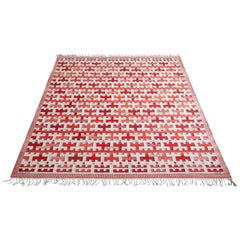Rodbroka Rug
Recent Sales
Vintage 1950s Swedish More Carpets
Wool
Vintage 1950s Swedish More Carpets
Wool
Märta Måås-Fjetterström for sale on 1stDibs
Märta Måås-Fjetterström was the leading figure in Swedish textile design in the early 20th century. Through her rug-weaving studio, MMF AB, Måås-Fjetterström introduced a modern and cosmopolitan spirit to the tradition-bound craft, creating some of the era’s most sublime rugs and carpets — works that are elegant yet have a handmade warmth and honesty.
Måås-Fjetterström was the daughter of a small-town minister, and her creative bent led her to study drawing at the School of Industrial Arts in Stockholm between 1890 and 1895. She became an art teacher after graduating and began drafting textile designs in the late 1890s. At the time, Sweden was experiencing many of the same cultural concerns that fueled the English Arts and Crafts movement: fears that industrialization was causing many traditional handicrafts to wither into extinction. The state supported numerous artisan workshops, and Måås-Fjetterström was hired as director of a weaving studio in the southern city of Mälmo in 1905. She was dismissed six years later for insisting that artisans be allowed to create original patterns rather than merely copy old ones.
She traveled widely in search of design inspirations, and in 1919 — thanks in large part to the patronage of Ludvig Nobel, grand-nephew of Alfred Nobel, who commissioned her to make all the rugs for a new country manor hotel — Måås-Fjetterström opened her own workshop. There she trained many of Sweden’s best modern weavers, including Barbo Nilsson and Marianne Richter (the latter, a widely celebrated mid-century modernist designer, became a leader at Måås-Fjetterström's atelier after its founder's death in 1941).
A major exhibition in Stockholm in 1934 brought public acclaim, a reputation secured worldwide by exhibitions at the British Museum in 1936 and the Metropolitan Museum of Art in New York in 1939. Måås-Fjetterström’s company, MMF AB, is still in operation, and most of her roughly 700 designs are available for fabrication.
A broad range of influences can be seen in Måås-Fjetterström’s designs, among them Art Nouveau and classic Near Eastern and Asian styles. Her rug patterns fall roughly into two groups: The first includes stylized floral and other naturalistic motifs as well as modernized folkloric themes. The second comprises those employing geometric “tiles” in a formal composition based on that of Persian rugs, with an intricate border surrounding a central medallion.
Måås-Fjetterström generally used a subtle color palette: Soft pastels predominate, punctuated by the odd vibrant note. Her rugs are remarkable for their flexibility of use in decor schemes. They are a perfect complement to simple modern furniture in both blond and darker finishes; at the same time, the rugs can act as a perfect calming foil to more ornate historical styles. Måås-Fjetterström's creations, particularly signed vintage pieces, are highly collectible. Her designs are found in the world's leading museums, including the Metropolitan Museum of Art, the Victoria & Albert Museum and the Nationalmuseum in Stockholm.
Find a collection of vintage Märta Måås-Fjetterström rugs and carpets on 1stDibs.
Finding the Right area-rugs-carpets for You
Antique, new and vintage area rugs and carpets are a simple way to add warmth and style to any space. Area rugs can be seasonal or changed with other decorative objects to refresh an interior. Carpet piles materials can vary from wool and cotton to silk and synthetic fibers, and the purpose of a floor covering can range from reducing noise to offering a place to sit.
Vintage rugs can ground a space, and arranging furniture around them creates a measured focal point. Key furniture pieces can be placed on the rug or just the legs, such as with furniture like coffee tables in your living room.
So, how can you tell if a rug is high quality or vintage?
The three main components that determine the quality of a piece are the dyes, the wool and the number of knots per square inch. Ultimately, however, if you want to be sure the rug you’re buying is truly an antique, it is best to consult an expert.
If you want a creative design that stands out, area rugs or carpets can provide layers of color. Rugs and carpets reflect a global heritage of textiles and weaving, such as ornately patterned Persian and Indian designs. Visually striking Chinese rugs can add a delicate touch of color, while modern rugs make a statement with their geometric patterns.
Turkish rugs, with their ruby reds and misted blues, their entwined botanical designs and rhythmic geometries, are as beloved today as they were in the 13th century. The West’s current infatuation with Moroccan and North African tribal rugs stretches to the mid-20th century, when modern furniture designers embraced bold geometric patterns and even bolder palettes as counterpoints to form-follows-function interiors. Alvar Aalto, Frank Lloyd Wright and Le Corbusier were among the designers who used these rustic, natural rugs to offset austere interiors.
If you properly maintain your antique and vintage rugs, they will last for many years. When you’re thinking about how to clean a rug, it is important to keep in mind that your vacuum is not too harsh for your favorite floor covering. Frequent vacuuming is in fact necessary to remove everyday dirt that otherwise wears down the pile. Omri Schwartz of Nazmiyal does, however, stipulate that “it’s best to use an ordinary suction vacuum without bristles, as the bristles can damage the rug’s pile.” Rotating the carpet every couple of years is also recommended — it ensures that the rug gets even foot traffic.
On 1stDibs, find a vintage rug or carpet to add a layer of beauty and function to your room.

